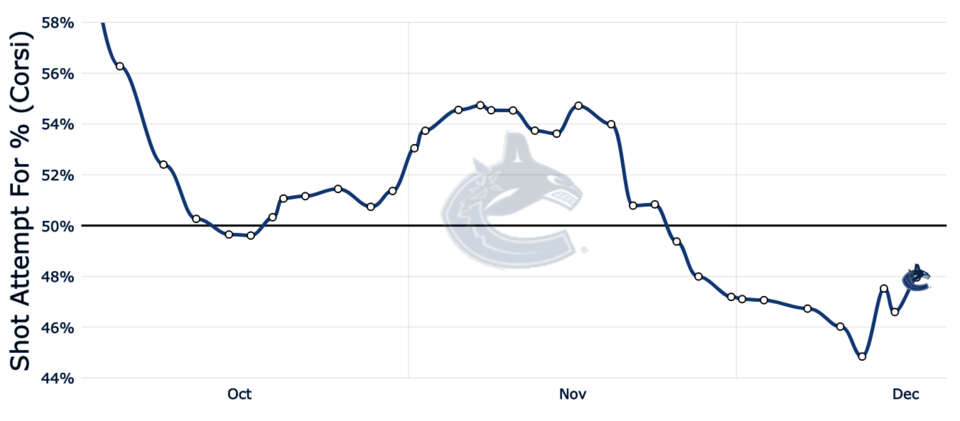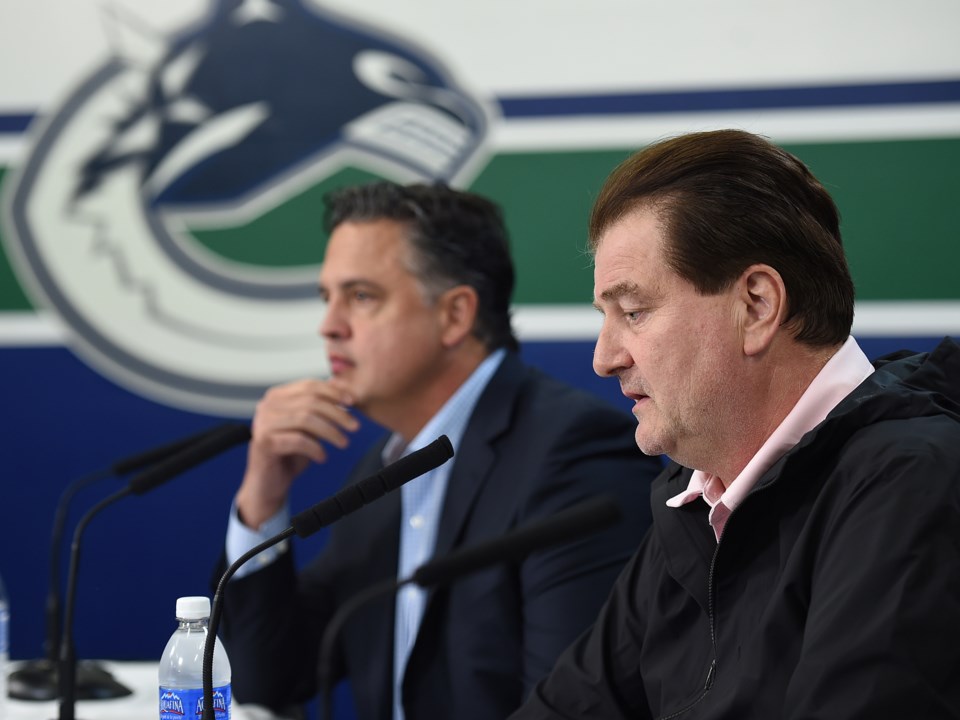“The heat is on, on the street...the pressure’s high...tell me, can you feel it?”
Was Glenn Frey singing about the Canucks’ Travis Green and Jim Benning in his from the Beverly Hills soundtrack? Without evidence to the contrary, we must assume that he was.
After the Canucks’ uninspiring loss to the Montreal Canadiens on Tuesday, the knives came out among their fanbase. Sports talk radio was abuzz with fans calling for the firing of Jim Benning and/or Travis Green, while the hashtags #FireBenning and #FireGreen both trended across Canada on Twitter.
It’s safe to say that the seats got a little hotter under both Benning and Green, as a fanbase (and ownership) eager to see the Canucks get back to the playoffs started to crack with realization that they might not be as close to reaching the postseason as they might have hoped. The heat is, indeed, on.
The truth is, the Canucks likely aren’t as bad as they’ve seemed in recent days, but a fantastic start to the season may have raised expectations too high.
Prior to the start of the season, pundits and analytical models were , predicting, on average, around 87 points by the end of the season, landing them 5th or 6th in the Pacific Division, just a little outside the playoffs. If those were your expectations, the Canucks are not far off — they’re currently 5th in the Pacific and on-pace for 84 points.
Canucks fans were a little more optimistic. A saw 60.8% of Canucks fans predicting a trip to the 2020 playoffs, while a revealed that Bulies are a little more cynical than your typical Canucks fan, with 51.2% predicting a postseason berth. Still, that’s a majority, if a slim one.
Then October happened.
The Canucks came storming out of the gate to start the season, perhaps aided by one of the easier schedules in the league. By Halloween, the Canucks were 8-3-1, landing them second in the Pacific Division with games in hand on the first-place Edmonton Oilers. They had an excellent goal differential and impressive underlying statistics to go with that hot start, suggesting that they were more than a paper tiger.
Since the end of October or, more accurately, after November 5th, the Canucks have come crashing down to earth from their hot start. After flying so close to the sun to start the season, the subsequent mediocrity has felt even worse than if they had been mediocre since opening night.
Going into November, . It featured a much harder schedule, with more games in fewer nights, giving them a lot less rest. In addition, injuries started to set in: Micheal Ferland suffered a concussion just before November, Brandon Sutter got hurt in mid-November, Jay Beagle in late-November, and Alex Edler just before December, among others.
The result hasn’t exactly been free fall, but the Canucks are 7-12-1 since November 5th, with just four wins in regulation in that time. The longest outright losing streak in that time was just four games, but the Canucks haven’t been able to string any wins together either.
The Canucks’ underlying numbers, which were so good through October, have also settled into mediocrity: they’re currently 13th in the NHL in score-adjusted corsi percentage, 21st in scoring chance percentage, and 14th in expected goals percentage, all according to .
Since those numbers were so good to start the season, that means they’ve been quite bad since. For instance, looking at a 10-game rolling average of the Canucks’ corsi percentage over the course of the season via , we can see how the team was performing well until early-to-mid November, when the bottom fell out. Heading into late December, the Canucks’ possession numbers are still underwater.

Another way to look at how the Canucks’ performance has changed over the course of the season is via the heatmaps on HockeyViz. One of the more entrancing visuals on the site is the animated heat maps that bear a certain resemblance to a lava lamp.
All you need to know to read the charts is that red means more shots than league average from that area, while blue means fewer shots than league average. On offence, more red in dangerous areas is good; on defence, more blue in dangerous areas is good.
Here are the Canucks’ shots for over the course of the season.
There are two striking stretches of games for me: late October, when the Canucks have a sea of red in front of the opposition net; and late November, when that sea turns bright blue. While we see some slight improvements in early December, the problem seems clear, if illustrated in a trippy way: they haven’t been getting enough scoring chances from dangerous areas.
Even in mid-December, when the Canucks started getting more shots from the slot, there are still nowhere near as many shots from in and around the crease area.
The pattern we see in their shots against, however, is a little different. The Canucks were good defensively to start the season, largely preventing shots from the middle of the ice, with a little trouble in mid-October. Things got uglier in mid-November, but they started tightening up in late November, allowing fewer scoring chances from in tight.
We could hypothesize that the lack of scoring chances for the Canucks and the prevention of scoring chances against went hand-in-hand in late November: as the Canucks tightened up defensively, they started taking fewer chances offensively, resulting in fewer scoring chances either way.
In December, things start to get ugly, coinciding with the injury to Alex Edler, which has had a detrimental impact to the Canucks’ defence corps. While Quinn Hughes has kept his head above water since Edler’s injury in terms of corsi and scoring chance percentage, as has his frequent partner Tyler Myers, the rest of the Canucks’ defence has not even come close.
What does this all tell us?
I think the most important thing is that the Canucks’ slide in the standings hasn’t just been a result of bad bounces or regression: they’ve legitimately played worse. At the same time, this also shows that the Canucks’ strong play to start the season wasn’t just good luck or fortunate bounces: they legitimately played well.
Sure, we could say the same thing just by using our eyes, but the eyes can be deceived. We’re prone to confirmation bias, looking for things that confirm what we already believe. The numbers, on the other hand, are unbiased. They can be interpreted in a biased fashion, but mostly they just show what happened on the ice.
Can the Canucks turn things around? Certainly. This could just be a rough patch and the Canucks could rebound on this homestand. Edler could return from injury soon and reinvigorate the Canucks’ defence. Bo Horvat could find his scoring touch again and lead the Canucks back into the crease for scoring chances and goals.
What this doesn’t tell us is who’s to blame. Canucks fans might be split on whether Jim Benning or Travis Green is more to blame for the Canucks’ slide, but the slide is real and should not be ignored.
��



